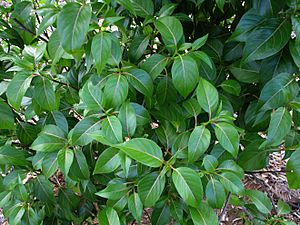Hawai'i dogweed facts for kids
Quick facts for kids Hawaiʻi dogweed |
|
|---|---|
 |
|
| Conservation status | |
| Scientific classification | |
| Genus: |
Bobea
|
| Species: |
sandwicensis
|
The ʻAhakea tree, also known as Hawaiʻi dogweed (Bobea sandwicensis), is a special kind of flowering tree. It belongs to the coffee family, called Rubiaceae. This tree is found only in Hawaiʻi, which means it is endemic there.
It grows in different places across the islands. You can find it on lava plains. It also lives in dry forests and coastal mesic forests. These are forests that get a medium amount of rain. The 'Ahakea tree grows from about 330 feet (100 meters) to 4,000 feet (1,220 meters) above sea level.
You can spot 'Ahakea trees on the islands of Oʻahu, Molokaʻi, Lānaʻi, and Maui. Sadly, this tree is facing threats. Its home is being lost because of habitat loss. Also, other plants that are not native to Hawaiʻi are growing too much. These "invasive species" compete with 'Ahakea for space and resources.
Contents
What is the 'Ahakea Tree?
The 'Ahakea tree is a beautiful part of Hawaiʻi's nature. It is known for its pretty flowers. These flowers are a key feature of the tree. The tree's scientific name is Bobea sandwicensis. This name helps scientists around the world know exactly which plant they are talking about.
The 'Ahakea is part of the coffee family. This family includes many plants. Some of these plants are important for food or medicine. But the 'Ahakea tree is special because it only grows in Hawaiʻi. It is a unique part of the islands' ecosystem.
Where Does 'Ahakea Grow?
'Ahakea trees are very adaptable. They can grow in many different environments. One place they thrive is on lava plains. These are flat areas formed by old lava flows. The trees find a way to grow even in rocky soil.
They also live in various types of forests. Some 'Ahakea trees prefer dry forests. These areas do not get a lot of rain. Other 'Ahakea trees grow in coastal mesic forests. These forests are near the coast and get more moisture.
The tree can be found at different heights above the ocean. It grows from low elevations to higher mountain slopes. This shows how tough and flexible the 'Ahakea tree is. It can survive in many different conditions across the Hawaiian islands.
Why is 'Ahakea Special?
The 'Ahakea tree is a true Hawaiian native. It is an endemic species. This means it naturally grows only in Hawaiʻi. You won't find it growing wild anywhere else in the world. This makes it a very important part of Hawaiʻi's natural heritage.
Endemic plants like 'Ahakea are unique. They have evolved over a long time to fit perfectly into their Hawaiian home. They are part of the delicate balance of the islands' ecosystems. Losing them would mean losing a piece of Hawaiʻi's special natural history.
What Threats Does 'Ahakea Face?
Sadly, the 'Ahakea tree is considered vulnerable. This means it is at risk of disappearing. There are two main reasons why this tree is in danger. These threats are habitat loss and competition from other plants.
Protecting 'Ahakea's Home
One big problem for 'Ahakea is habitat loss. This happens when the places where 'Ahakea trees grow are changed. For example, land might be cleared for buildings or farms. When this happens, the trees lose their homes. They can no longer grow and thrive there. Protecting these natural areas is very important for the 'Ahakea's survival.
Battling Invasive Plants
Another threat comes from "invasive species." These are plants that are not native to Hawaiʻi. They were brought to the islands by people. These invasive plants grow very fast. They can take over the space and resources that 'Ahakea trees need. They compete for sunlight, water, and nutrients in the soil. This makes it hard for 'Ahakea to grow and reproduce. Efforts are being made to remove these invasive plants. This helps give native trees like 'Ahakea a better chance to survive.


